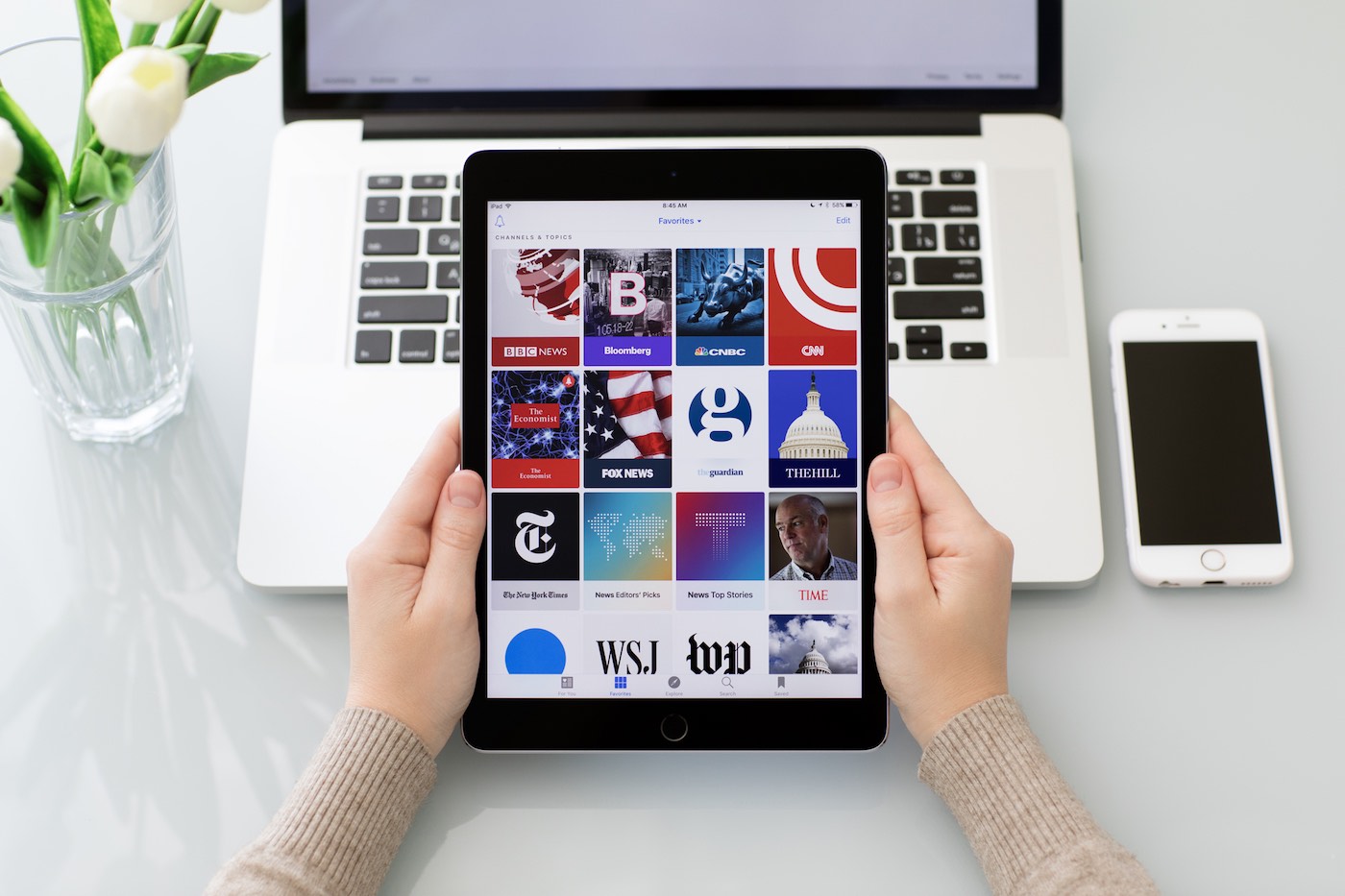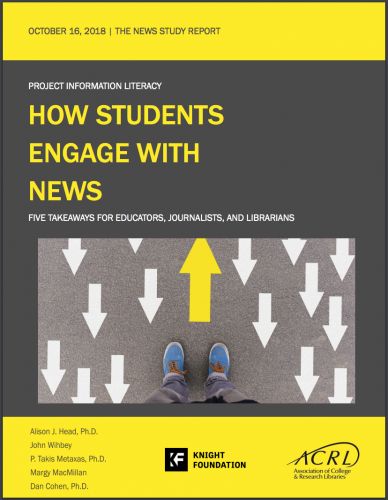News digests to the rescue?
A new report finds digests are an important part of the Z generation’s formula for staying current, but are they a panacea for “fake news,” or another Pandora’s Box?
Sam is a sophomore enrolled in a mid-sized U.S. university and majoring in film. He follows news about politics, science, and education. Sam admits he’s got limited time to read the news each day, so he scrolls headlines on his phone while he’s in class, and may click a headline to read more – but only if it grabs his interest.
“The speed of news is changing; it really has increased with the amount of news that’s out there,” Sam tells researchers doing a national study on the role news plays in students’ lives. “News stories happen and appear so quickly, it used to be you had to wait a day before you got the news, but now it is so quick, it’s a lot to sort through.”
Seeking solutions for managing the daily inundation of new information is nothing new. Almost three quarters of a century ago, Vannevar Bush wrote an essay entitled, “As We May Think” for Atlantic Magazine and claimed that the “publication has been extended far beyond our present ability to make real use of the record.” Bush was talking about information overload, and his solution to the glut was his Memex machine, a blueprint for what became the World Wide Web.
A key feature of this novel electromechanical storage device were “trails.” Trails let users virtually connect ideas from one source to another within a large self-contained library, much as hypertext links do today. Trails, Bush wrote, “beat the mind decisively in regard to the permanence and clarity of the items resurrected from storage.”
Fast forward to 2019 where news apps like Apple News and Yahoo! News, like Bush’s device, present a technological solution to news overload, serving as modern day cairns for navigating the onslaught of daily news. These prepackaged news services deliver a culled and curated smattering of the latest news from user-selected sources, such as The New York Times, Buzzfeed, People, and Vox.
As a way to make sense out of the endless barrage of stories cycling through the Web each day, these digests help young news consumers simplify the labor of staying informed. As a team of researchers at Project Information Literacy, that included Northeastern University School of Journalism assistant professor John Wihbey and Dean of the Libraries Dan Cohen, we looked at this phenomenon in our most recent study. More than half of the 5,844 U.S. college and high school students that we surveyed had gotten news in the previous week from some kind of a feed pushed to their mobile devices. As one social science major in college told us:
A digest of top news stories is definitely
in our formula of what makes a good news source, since we often just feel so inundated with all the information that’s available on the Web — all the different news sources we can go to. But to have news in a small, simple, digestible form where if you’re
interested in a story you can go and read more about it and if you’re not you just go to the next item.
News plays a critical role in helping students navigate and understand the world, engage with social and learning communities, and participate in a democracy. A full 82 percent of survey respondents said news is important to democracy. “Who would speak for the community and marginalized groups if the news wasn’t present?” a science student told us in a follow-up interview. “People should follow the news. They should know what is going on in the world.”
Choices for news from social media to online newspaper sites have never been more abundant, though objective coverage is increasingly mixed in with a deluge of poorer-quality online content and misinformation. Accordingly, 51 percent of the students we surveyed said it was difficult to determine the most important stories of the day. Another 45 percent said they were unable to discern “fake news” from real news. And, 68 percent agreed that the sheer amount of news on any given day was overwhelming; confirming Pew Research Center’s survey results from last year about a similar demographic and news fatigue.
Digests are explicitly designed to address thorny issues of news consumption in the age of factual recession. They help students resolve conflicting facts or reconcile differing news accounts. Further, giving tacit approval to particular sources of news they commonly draw upon, including The Washington Post, Buzzfeed, or BBC, digests convey a sense that they represent news you can trust. And, digests, as one student at a liberal arts college said, “give you enough of the news so you can talk with someone about a story if they were to bring it up.”
Our findings show knowing about news is valuable social capital for students in conversations with their peers and instructors. More than a FOMO factor, students saw discussing news with others gave them a voice about larger causes and the ability to change people’s minds. For many, digests enable a rapid consumption of top stories of the day from trusted sources and address some of what students told us their key concerns, such as Kim Jong-un’s missile testing, the “March for our Lives,” the fate of their DACA classmates, or Roseanne Barr’s racist tweets. It is little wonder that digests are seen as an efficient way to keep up with important conversations.
While students also reported getting news through social media, including through news channels on Snapchat (a news source especially popular with news consumers under 30, according to a Pew Research survey), many voiced strong concerns about accuracy and bias. As one student included in a write-in comment, “I spend more time trying to find an unbiased site than I do reading the news I find.” Another explained why she was hesitant to share news. “Not being able to distinguish whether news is accurate or not is a part of why I do not share on my social media platforms.”
In a few cases, students expressed general suspicion of mainstream news sources, but far more described a preference for publications with established reputations for accuracy and even-handed reporting, such as The New York Times or Washington Post. While a large majority of students used both social media and nontraditional sources for news, many expressed caution about spreading inaccurate information in shares or retweets that might cause them embarrassment later on. In contrast, a recent study published in Science Advances found people over 65-years-old shared nearly seven times as many items from fake news domains as the youngest age group in their study. Turning to news digests is not only convenient, it is a way of focusing on news that through some process has been vetted.
With reportedly 90 million subscribers, Apple News holds a top spot as a news aggregator, and it looks like this trend will continue. Another go-to some students in our study mentioned were e-newsletters, such as theSkimm or Need2Know, that sent out a daily mix of news with fun, humor, and lighter stories to balance hard news, or commentary.
To its advantage, a news digest to some extent performs the same role as a half-hour nightly news program: it delivers a brief summary of a handful of stories deemed important. Students in our study were more likely to get their news last week from phone apps (55 percent) or social media (89 percent) than from television (45 percent), either real-time programming or segments posted on YouTube or elsewhere on the Web.
While confirming prior research about the decline of younger adults watching news on television, this preference brings up another significant distinction: though broadcast news relays the days events selectively and in brief, it is a journalistic enterprise. The tech platforms on which our study subjects rely deliver news without actually creating it.
Other players in the news space, such as Google (which offers a news digest app for phones) and Facebook (with its influential news feed), both claim they are not in the news business, and they are simply technology companies that happen to have robust distribution channels, i.e., channels that carry a lot of clout in terms of which stories reach which audiences. Unlike Apple News, which employs a team of journalists to select stories from a limited number of news sources to feature, Google and Facebook rely, at least in part, on proprietary algorithms and personal data profiles to curate news.
Facebook, in particular, has faced criticism for encouraging the spread of misinformation and even Russian-sponsored disinformation. In response, the company changed its algorithm to minimize news stories from publishers in favor of posting more content about “friends and family,” sending news organizations scrambling. Though journalists increasingly rely on tech platforms for delivering the news, in exchange they must give up not only a significant share of ad revenues but also influence around which news stories appear in feeds and digests.
As young news consumers, along with many of the rest of us, are increasingly rely on intermediaries for news, what those intermediaries are and how they operate deeply matters. The traditional wall between news reporting and the business end of news is dissolving fast as digests, crafted by people or algorithms, select and disseminate news from a variety of sources. In the case of Apple News, those sources are limited, and news organizations are forced to pitch stories for a coveted spot. Local news, already struggling to survive, may be left out altogether as West Coast tech companies strike deals or scrape the Web for popular content to drive up page views.
Knowing who actually reports the news and which news sources are reliable may grow fuzzier as stories are aggregated into a uniform blur. And, as news is distilled into easily-digested bites, context and complexity may be sacrificed for simplicity and efficiency. Those students who think it’s their civic duty to be informed might find themselves relying on simple, even addictive, superficial summaries of the news. And, they may be far less informed than we may think.
About the Authors
Alison J. Head, Ph.D. is the Founder and Director of Project Information Literacy (PIL) and a Senior Researcher at the metaLAB (at) Harvard University.
Barbara Fister is the Scholar-in-Residence at PIL and an Academic Librarian and Professor at Gustavus Adolphus College.
Margy MacMillan is Senior Researcher at PIL and Professor Emerita at Mount Royal University.
- News digests to the rescue? - March 15, 2019






